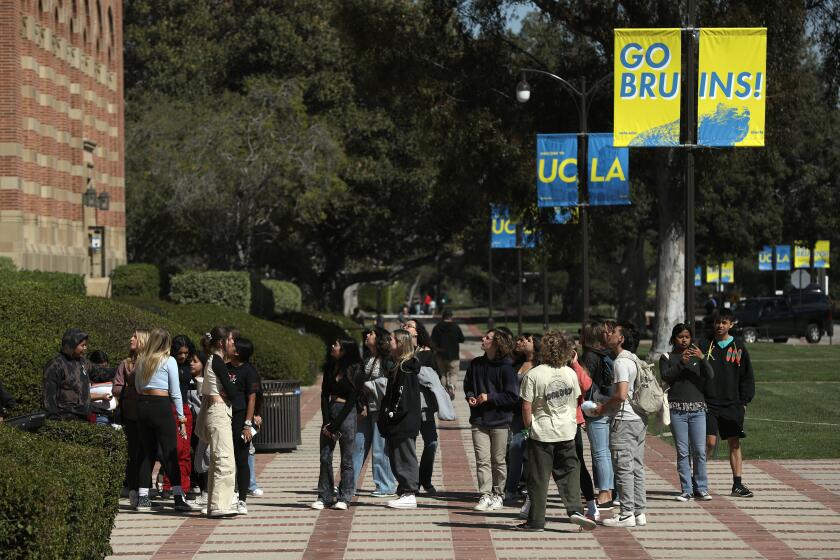Of Primary Concern: Little Learners
- Share via
Not many first-graders can call themselves the big kids on campus at Los Angeles schools. Yet that’s exactly the case at the new Richard Riordan Primary Center in Highland Park.
Although most elementary schools in the Los Angeles Unified School District teach kindergarten through fifth grade, the Riordan Primary Center teaches only kindergarten and first grades. The 390-student campus is one of a dozen such primary schools that are models for what the district hopes will be an important part of its massive building program.
Primary centers -- small schools serving students in the first two, three or four years of their public school education -- still are rare on the district landscape. Of the district’s 432 elementary schools, only 12 are primary centers, most built recently. But 22 more are under construction and scheduled to be completed in the next few years.
“The idea is to create a nurturing environment where little kids get an education in an environment that is proper to their size and their needs,” said O’Malley Miller, an attorney who headed a task force in the administration of former Los Angeles Mayor Richard Riordan to push for primary centers. “The doorknobs are where they are supposed to be for a littler person. The toilets are the size for a little person.”
Los Angeles’ tight real estate market is a big reason for the centers: Those schools take up less space and displace fewer houses and other buildings. A typical elementary school might serve between 500 and 1,000 students, on a campus of 3.6 acres. The average primary center enrolls closer to 300, on 2 acres -- much easier to find in such a crowded and expensive city as Los Angeles.
Small schools for small children also are an easier sell than high schools, which need large athletic fields and may trigger protests from potential neighbors who fear traffic, noise and crime.
Many educators say that younger children flourish in more intimate schools devoted to their particular needs and without the sometimes bullying presence of older children.
“We learn the basic skills in kindergarten, first and second grades -- a love for reading and basic math concepts,” said Erika Karres, an elementary educational expert and author in North Carolina. “If they are not in place, students limp for the rest of their educational lives....The issues we need to deal with in those grades are different than those in third, fourth, fifth and sixth grades. In the past we have lumped them together.”
Still, not everyone agrees that primary centers are the best setting for youngsters.
Samuel J. Meisels, president of Erikson Institute, a graduate school in child development based in Chicago, said that primary centers’ narrow grade range sometimes isolates teachers and may prevent them from properly preparing students for the rigors of the later years of elementary school.
“There is now early evidence -- not at all definitive -- that shows somewhat better outcomes for kids who are not in these very small age-range schools,” Meisels said. “I really think that the best investment would be, not two grades, but five years. You build up a teaching corps and you have professional development that helps everyone.”
The Los Angeles district does not have test scores to show whether primary centers are academically superior to regular campuses -- in part because most standardized tests start in second grade, and some of the district’s primary centers go only through first grade. And it’s too early in the construction program to detect a trend, officials say.
Districts in other states have built primary centers -- among them Rhode Island, Idaho, Maryland, Pennsylvania and Washington -- mostly as a relatively easy way to ease overcrowding.
But none has as ambitious an expansion program as L.A. Unified, where the centers are part of a complicated formula to move away from year-round schools by building more than 120 new elementary, middle and high schools over the next few years.
Even during construction, Riordan Primary Center, said Principal Anna Barraza, was a “guinea pig” for the ones that will follow. Visitors came to the $11-million school, to see “what worked and what could be changed. What kind of furniture.”
The school, Barraza said, “has a different look than what you think of when we think of elementary schools in LAUSD.”
That difference was evident on a recent morning at the Riordan Center, where many students are learning English as a second language and most receive free or reduced-price lunches. Five- and 6-year-olds rowdily bounced red rubber balls on a spacious playground and worked on spelling in classrooms with large picture windows, brightly decorated inside and out.
Primary center principals point out the rubberized play areas and student vegetable gardens with particular pride. And they say they get to know all their students.
“You can see the difference,” said John Samaniego, principal of MacArthur Primary Center, a colorfully painted campus that opened last year across the street from MacArthur Park. “We are fortunate, because we have a small staff and small campus, are able to have teachers and students excel.”
Miguel H. Garcia, a literary coach for Los Angeles Unified who spent part of the year at MacArthur, said that the layout “eliminates a lot of stress that goes along with learning. You can walk around anywhere -- you always feel safe. The walls are higher, but not too high. They seem huge for second-graders and safe for teachers.”
Priscilla Vasquez, a mother of two children at MacArthur Primary Center, said: “It’s like a family here. They grow together, and the kids get along great because it’s not such a big school.” Vasquez said the weekly “coffee with the principal” gives parents “the opportunity to express their feelings, how we feel. It’s just great.”
Another important result of primary centers is relieving other schools of enrollment pressures. After the Riordan Primary Center opened, enrollment at Monte Vista Elementary School, across the street, decreased by 40%, as that elementary school was able to shift from K-5 to second through fifth grades. And most of the students who had been bused away from their neighborhood schools were able to enroll locally.
Idalia Valdovinos, a teacher at Arco Iris, a primary center that has been serving kindergarten through second grades on its campus south of downtown for 10 years, said that the school’s close-knit nature had been a benefit.
On a recent morning, she sat at a child’s-size table inside her classroom, patiently helping her second-graders with their writing skills. Karina Galindo, 6, told Valdovinos about a visit to a local pool; Arturo Grimaldo, a shy 7-year-old, covered his paper so that a reporter could not see his masterpiece: an account of a family trip to Sacramento.
“I notice a difference for the kids,” said Valdovinos, who has been teaching at the center for four years. Because of the school’s format, she has been able to teach the same class for the last three years, cycling with her students from kindergarten to first and then second grades.
“I don’t have to deal with discipline as much,” Valdovinos said. “I know how far to push them, and who to keep my eye on.”
Robin Kramer, a former deputy mayor in the Riordan administration, said that the most important legacy of the primary centers may never be fully measured by test scores or other academic standards.
“These primary centers, because of their very size and focus, have advantages if done well,” she said.
They can help to create “a community, a learning community in its truest and most genuine sense. Not just in a rhetorical way.”
More to Read
Sign up for Essential California
The most important California stories and recommendations in your inbox every morning.
You may occasionally receive promotional content from the Los Angeles Times.









